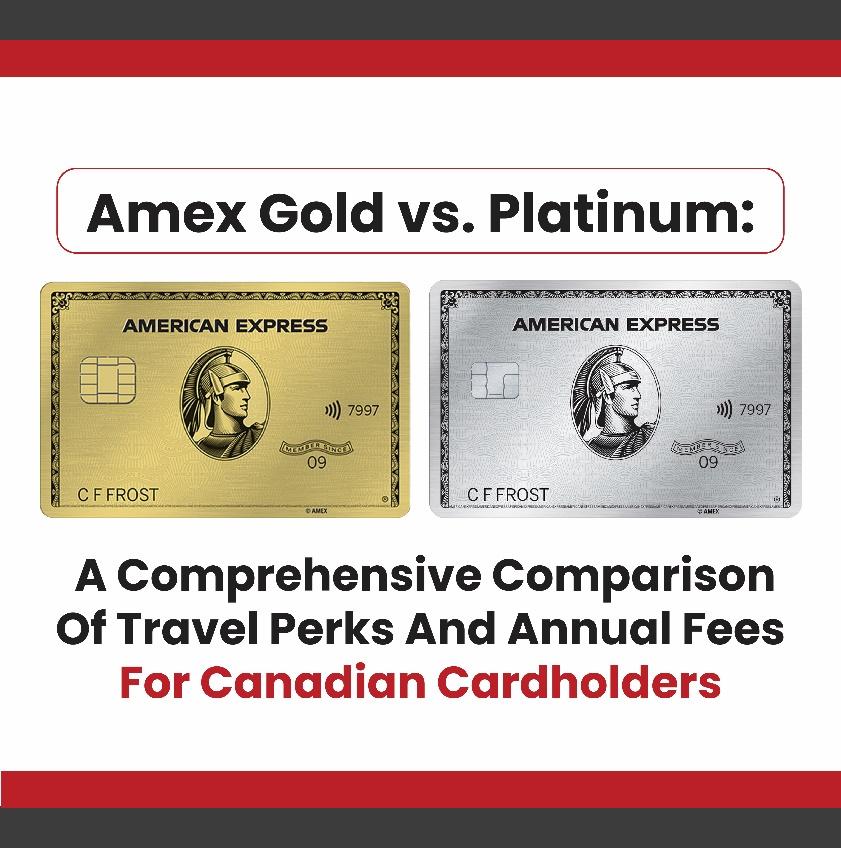Picture this: You’re out at your favourite Toronto bistro, savouring a steak frites and a glass of Syrah, when the bill arrives. You reach into your wallet and pause. Should you pull out your American Express Gold or the Platinum? Maybe you’re trying to decide which to apply for. Maybe you already have one, and you’re wondering if the other could offer more.
In Canada, the Amex Gold vs. Platinum debate is more than just a status symbol discussion. It’s a deep dive into what you value most: travel perks, points, flexibility, or simply getting more from your everyday spend. While both are premium cards issued by American Express Canada, they cater to different lifestyles, spending habits, and financial priorities. This long-form comparison blog will break down every angle, from fees and rewards to insurance and travel perks, to help you decide which card aligns best with your goals.
Whether you’re looking to elevate your travel experience, maximize dining rewards, or invest in a card that gives you tangible benefits, this comprehensive Amex Gold vs. Platinum guide will help you make the smartest choice.
The Basics: What Are These Cards?
Before we pit them head-to-head, let’s take a moment to define the contenders clearly in this comparison.
The American Express Gold Rewards Card, commonly referred to as the Canada Amex Gold, stands out as a premium charge card that offers exceptional rewards for everyday spending. This card excels particularly when it comes to categories like dining out, grocery purchases, and travel-related expenses. Its ability to earn points quickly in these areas makes it an attractive option for many consumers.

The Amex Gold is ideal for users who desire a versatile travel card that delivers significant benefits without the ultra-premium price tag typically associated with higher-end cards. The flexibility it provides makes it suitable for both casual spenders and those looking to maximize their rewards on everyday purchases.
In contrast, the American Express Platinum Card represents the luxury end of the travel card spectrum, boasting a steep annual fee that reflects its premium offerings. This card is designed for frequent travellers and high spenders who are willing to invest in their travel experiences.
With unparalleled access to airport lounges around the world, exclusive concierge services, and high-tier travel insurance, the Platinum Amex provides significant value to those who prioritize comfort, convenience, and a superior travel experience. This card caters to individuals who value the benefits and experiences it unlocks over the straightforward cashback that other cards might offer.
So, when it comes down to Amex Gold vs. Platinum Canada, which card brings the real value to users? The answer ultimately depends on an individual’s spending habits, travel frequency, and what they prioritize most in a credit card. Let’s dive deeper into the features and benefits of each card to find out which one truly delivers the best value for its cardholders.
Annual Fees: How Much Are You Really Paying?
Let’s be blunt — neither of these cards is cheap.
The American Express Gold Card charges an annual fee of CAD 250, and adding a supplementary card costs $50.
The Amex Platinum Card will set you back CAD 799 annually, with a supplementary card fee of $250 — the highest in the country among major cards.
So why the massive gap?
With Platinum, you’re not just paying for a card — you’re buying access. Think lounge access, elite hotel status, airport upgrades, and concierge services. The Gold card, by contrast, offers great rewards without those extravagant extras.
Verdict: If upfront cost is your concern, the Gold card offers more affordability. But if you’re a frequent traveller, the Platinum fee could pay for itself in benefits.

Rewards Structure: Where Do Points Add Up Faster?
Both the Amex Gold and Amex Platinum cards leverage Membership Rewards, one of the most renowned and flexible loyalty programs available in Canada. However, the way you accumulate points differs significantly between the two, and understanding these differences can help you make a more informed decision on which card suits your spending habits best.
The Amex Gold Card offers:
- 2 points per dollar on eligible gas, groceries, travel, and dining
- 1 point per dollar on everything else
Meanwhile, the Amex Platinum Card provides:
- 3 points per dollar on dining (including delivery apps and coffee shops)
- 2 points per dollar on travel
- 1 point per dollar on all other purchases
At first glance, the Amex Gold Card may seem like the better option for the average Canadian household, thanks to its broad category-based rewards. It provides a generous 2 points on essential spending like groceries, gas, and dining, which are key areas for most families. This makes it a fantastic option for everyday shoppers who want to maximize their rewards without having to focus on niche categories.
On the other hand, the Amex Platinum Card is tailored for individuals who prioritize higher-end travel and dining experiences. With 3 points per dollar on dining and 2 points per dollar on travel, the Platinum rewards those who dine out frequently and travel often, whether for work or leisure.
Let’s consider a real-world example to clarify further how these cards compare. If you spend $1,000 per month on groceries and gas, with the Gold Card, you’d earn 24,000 points annually (since both categories earn 2 points per dollar). However, if you opt for the Platinum Card, you’d only earn 12,000 points in those same categories (since both earn only 1 point per dollar).
However, if you spend $1,000 per month on dining and travel, the Platinum Card comes out ahead. You’d earn a total of 36,000 points annually (3 points per dollar on dining and 2 points per dollar on travel), compared to the Gold Card’s 24,000 points in those categories (since dining and travel earn 2 points per dollar with the Gold).
Verdict: The Gold card is the better choice for the average Canadian household, especially for those focused on everyday expenses like groceries, gas, and general dining. The Platinum card is the ideal pick for urban professionals, frequent travellers, or individuals who dine out often. The Platinum card truly shines in categories tailored to higher-end dining and travel spending, while the Gold card excels in offering broader, more versatile rewards.
Redemption Options: How Flexible Are Your Points?
Both the American Express Gold and Platinum cards utilize the Membership Rewards program, which is widely recognized for its exceptional flexibility in accumulating and redeeming points. This program allows cardholders to transfer their earned points to several prestigious airline partners, including Aeroplan, Avios, and Delta SkyMiles.
Additionally, points can be utilized to book a wide range of travel options directly through Amex Travel, offering users a variety of ways to spend their rewards. This versatility is one of the standout features of the Membership Rewards program, making it a popular choice among frequent travellers and those who seek to maximize their rewards.
One of the notable features of the Amex Gold card is the ability to use the Pay with Points option at checkout. However, it’s important to note that this typically results in a lower redemption value compared to travel bookings, so users should weigh their options carefully.
On the other hand, the comparison between the Platinum and Gold cards truly shines when evaluating their value per point. Platinum cardholders enjoy various advantages, such as special transfer bonuses and access to exclusive travel offers that can significantly enhance the overall value of their points. These enhancements often allow users to stretch their points much further, especially when they are planning travel-related expenses.
In conclusion, when it comes to redemption options, both cards essentially tie, as they offer a wealth of opportunities for cardholders. However, it ultimately depends on how users prefer to utilize their points. Those who frequently book travel or take advantage of the extra perks associated with the Platinum card are likely to find themselves deriving slightly greater benefits from it, making it the more advantageous choice for avid travellers.
Travel Perks: Where the Platinum Card Justifies Its Price
This is where the Amex Platinum vs. Gold discussion gets interesting.
The Platinum Card offers:
- Unlimited access to over 1,300 airport lounges worldwide, including the Centurion Lounge and Priority Pass
- $200 annual travel credit
- $100 NEXUS fee rebate
- Hotel elite status with Hilton and Marriott Bonvoy
- Premium concierge services
The Amex Gold Card offers:
- No lounge access
- No travel credits
- No elite hotel status
- Limited concierge access
For frequent travellers, these perks can offset the $799 fee quickly. One round-trip lounge visit with meals and drinks at Pearson’s Plaza Premium Lounge can easily be worth $70 per person.
Verdict: Hands down, the Amex Platinum wins for travel benefits. If you’re in an airport more than twice a year, this card could upgrade your experience immensely.
Insurance Coverage: Safety Nets Compared
When it comes to travel and purchase protection, the Amex Platinum card truly stands out. One of its primary advantages is its comprehensive insurance coverage, which offers extensive protection for a wide range of situations, giving cardholders peace of mind, especially during their travels. Here’s an overview of the insurance benefits provided with the Platinum Amex:
- Out-of-province emergency medical: Up to $5 million in coverage for trips lasting up to 15 days per trip.
- Trip cancellation/interruption: Covers up to $1,500 to $2,500 for unforeseen trip disruptions.
- Lost/stolen baggage: Provides compensation for lost or stolen baggage, up to $1,000.
- Additional coverages include hotel burglary, flight delays, car rental theft, and damage to rented vehicles.
These insurance benefits make the Platinum Card a standout option for frequent travellers, particularly those who want to ensure they are covered in multiple scenarios that could arise while on a trip, from medical emergencies to baggage loss.
The Amex Gold Card does offer travel-related insurance, but its benefits are more limited. The emergency medical coverage is still impressive, with up to $5 million in coverage, but it is restricted to trips of up to 15 days for individuals under the age of 65. The Gold Card does not provide the same level of protection for trip cancellations, and it does not extend to some of the additional coverages offered by the Platinum card, such as flight delays, car rental protection, or hotel burglary.
Verdict: If you are seeking comprehensive insurance coverage, the Platinum card is the clear winner. With its extensive range of protections, particularly for travel, it offers invaluable peace of mind, especially for those with unpredictable travel plans or those who travel frequently. While the Gold card provides basic coverage, the Platinum card takes the lead when it comes to ensuring you’re well-protected while on the go.
Lounge Access: Game Over, Gold
When it comes to airport lounge access, there’s a clear winner between the Amex Gold and Amex Platinum cards, and it’s not even close. To put it simply, the Amex Gold Canada card does not offer any form of lounge access. If you’re someone who values comfort and convenience during your travels, especially while waiting for your flight, this lack of access could be a significant drawback.
The Amex Gold Card offers no lounge privileges whatsoever. You won’t be able to access Centurion Lounges, Plaza Premium Lounges, or Priority Pass, which are some of the most sought-after lounges for frequent flyers. So, if you’re hoping to enjoy a peaceful and relaxing environment before your next flight, you’ll have to settle for the usual airport experience, which often includes crowded terminals and long queues.
In stark contrast, the Amex Platinum Card gives you unlimited access to several exclusive lounges worldwide, making it an incredibly appealing choice for travellers who prioritize comfort and relaxation. With the Platinum Card, you get access to:
- Centurion Lounges, which are known for their high-end amenities and quiet spaces to unwind.
- Plaza Premium Lounges are a popular choice among global travellers for premium services and dining options.
- Priority Pass, which grants access to hundreds of lounges around the world, including the ability to bring guests along with you.
- Maple Leaf Lounges are available for Air Canada itineraries, making it a great option for those who frequently fly with the airline.
Whether you’re flying out of Vancouver, Montreal, or Calgary, the Amex Platinum turns airports into serene havens, offering a more comfortable and luxurious pre-flight experience.
Verdict: For lounge access, the Platinum card is the clear winner. The Gold card can’t compete with the extensive lounge network available to Platinum cardholders, making it the obvious choice for frequent flyers who value comfort and relaxation while travelling.
Verdict: If you care about lounge access, the Platinum card is the only option.
Interest Rates and Charge Rules: Know Before You Swipe
Both of the cards being discussed are technically categorized as charge cards rather than traditional credit cards. This distinction is significant because it means that users are required to pay the entire balance in full at the end of each billing cycle. Traditional credit cards, in contrast, allow users the flexibility to carry a balance from month to month, typically incurring interest charges in the process. However, both the Amex Gold card and the Platinum card come equipped with Flexible Payment Options that provide a degree of leeway in handling larger purchases.
With the Amex Gold card, customers have the option to carry certain larger purchases over to the next month, but this does come with the caveat that interest will accrue on the remaining balance at a substantial rate, currently hovering around 30% APR.
It’s important to note that the flexibility granted by this option largely hinges on the individual’s credit history and overall credit profile. This means that not all users may be eligible for this feature.
The Platinum card also functions similarly in terms of payment options. Like the Amex Gold card, it is primarily designed not to accommodate the revolving of balances. If you find yourself in a situation where carrying a balance from month to month is a necessity, then it’s important to consider that neither of these cards is particularly suitable.
In evaluating both options, the conclusion seems clear: they are essentially tied in this respect. Both the Amex Gold card and the Platinum card are not designed for users who anticipate needing to resolve their debt. Instead, they cater to those who plan to make purchases and pay them off in full, making them ideal for responsible spenders who maintain their finances effectively.
Acceptance in Canada: Still a Weak Spot
Although American Express (Amex) has made significant strides in Canada, it still faces a major hurdle when compared to Visa and Mastercard in terms of merchant acceptance. This remains one of the key challenges for Canadian consumers considering the Amex Gold or Amex Platinum cards. While both cards enjoy widespread acceptance in many popular locations, they still fall short in some areas where Visa and Mastercard dominate.
Both the Amex Gold and Amex Platinum cards have relatively similar acceptance rates. Major merchants, including grocery stores, restaurants, large hotels, gas stations, and well-known retailers, typically accept American Express. For city dwellers or those in urban areas, you’ll likely encounter fewer issues using your card for day-to-day purchases.
However, small businesses, particularly those outside major urban centres, often decline American Express due to its higher processing fees. Additionally, provincial agencies and other public institutions tend not to accept Amex, leaving cardholders with limited options when trying to make certain transactions, especially in more rural areas.
If you reside in a major city, your experience with Amex card acceptance is likely to be smooth, especially at large chain stores and popular service providers. But as you venture into more remote regions or smaller, independent businesses, there’s a higher likelihood that your Amex Gold or Amex Platinum card will be rejected.
Verdict: Unfortunately, neither the Gold nor the Platinum card wins when it comes to merchant acceptance. American Express’ Achilles’ heel in Canada remains its limited acceptance, especially outside major cities and at small businesses. If you rely heavily on using your credit card at independent or regional merchants, you might want to consider Visa or Mastercard for broader acceptance.
Who Should Get the Amex Gold?
If you’re someone who:
- Spends heavily on groceries, gas, and travel
- Wants to earn travel points without a sky-high annual fee
- Isn’t focused on lounges or concierge services
- Wants strong insurance but doesn’t need luxury perks
Then the American Express Gold Card offers high everyday value. It’s one of the best starter premium cards in Canada.
Who Should Get the Amex Platinum?
If you:
- Travel more than twice a year
- Use lounges and appreciate VIP airport experiences
- Want elite hotel status and personalized travel bookings
- Need robust travel insurance and concierge services
- Value flexibility and rewards over cashback
Then the American Express Platinum Card is a lifestyle upgrade. It’s built for frequent travellers and high earners who want benefits to match their ambition.
Final Verdict: Amex Gold vs. Platinum — Which Card Wins?
There’s no universal answer — it comes down to how you live, spend, and travel.
- For everyday Canadians, especially families and foodies, the Amex Gold delivers excellent rewards, solid insurance, and great value for $250.
- For frequent flyers, digital nomads, and luxury seekers, the Amex Platinum is a powerhouse of travel perks that more than justifies its $799 fee.
Bottom Line: If you want an elite experience with lounges, upgrades, and peace of mind, go Platinum. If you prefer solid returns on daily spending without breaking the bank, go Gold.
Both are exceptional cards — it just depends on what you value more: function or luxury.
Where To Apply For The Best Canadian Credit Cards?
Great Canadian Rebates is an online platform that lets Members compare credit card options available in Canada and apply for the one that best suits their financial and lifestyle requirements. It’s free to join, and Members can also choose from over 700 well-known merchants and take advantage of great rebates, deals, and discounts.


